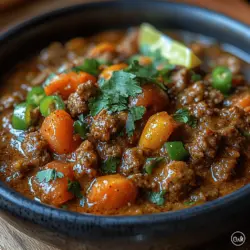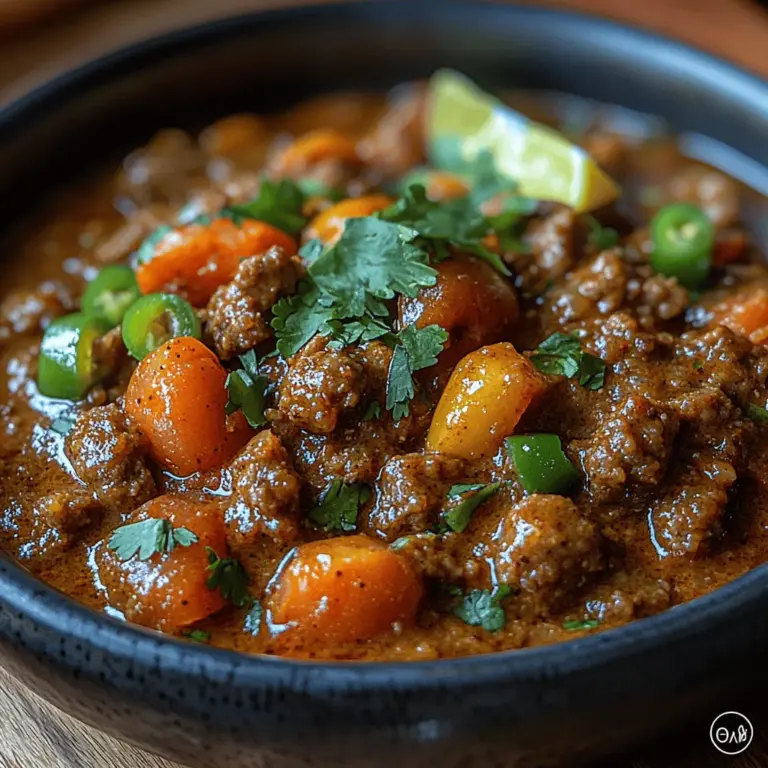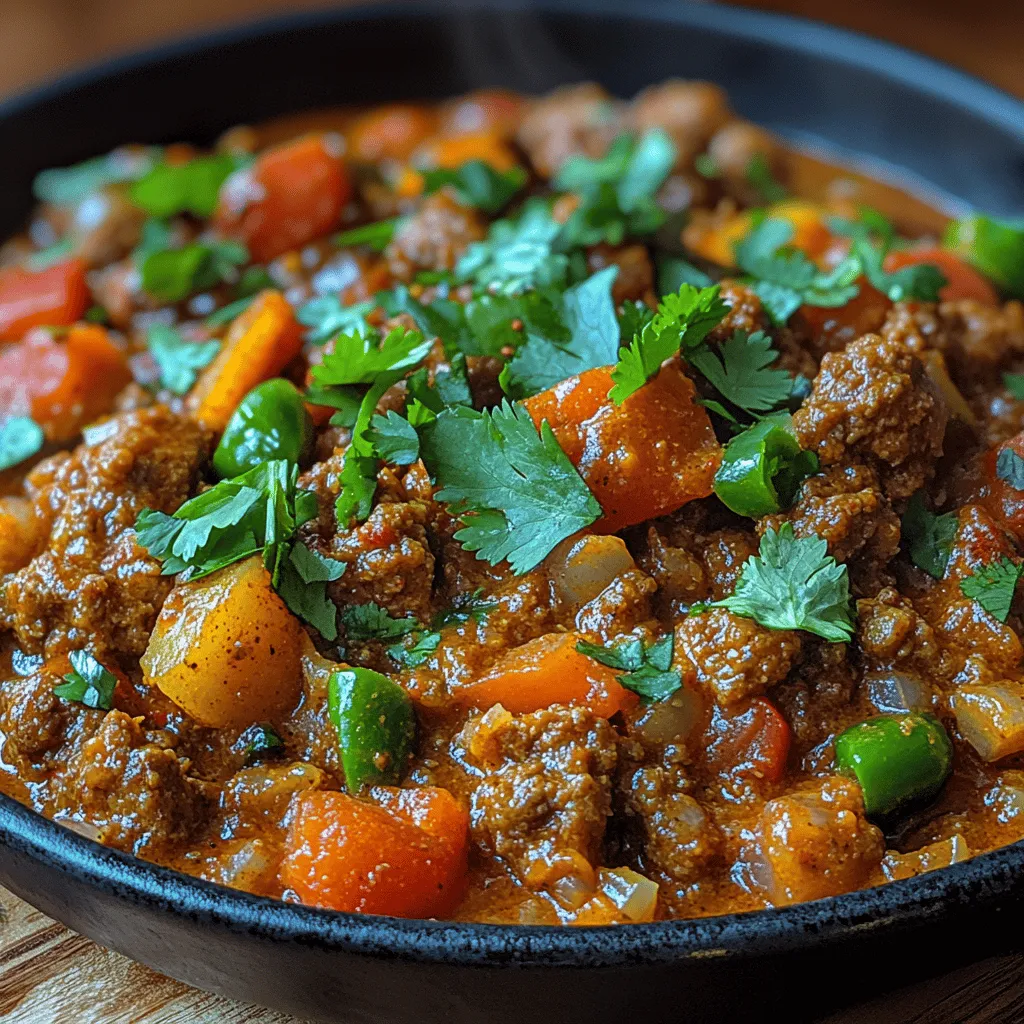Introduction
Qeema, a traditional Indian dish, is a vibrant and flavorful representation of comfort food in Indian cuisine. This dish, made from minced beef, is not just a meal; it’s a warm embrace on a plate that evokes memories of home-cooked meals shared with family and friends. In India, where food is deeply intertwined with culture and tradition, Qeema holds a special place in the hearts of many. Its rich flavors, aromatic spices, and hearty texture make it a go-to recipe for gatherings, celebrations, or simply a cozy night in.
The appeal of Qeema lies not only in its taste but also in its versatility. It can be served with a variety of sides, from steaming hot naan to fragrant basmati rice, making it a favorite across different households. As we delve into this recipe, you’ll discover the steps to create a dish that is not only satisfying but also packed with nutrition and flavor.
Understanding Qeema
Definition and Cultural Significance
Qeema, derived from the Persian word for minced meat, refers to ground meat dishes prevalent in Indian, Pakistani, and Bangladeshi cuisines. In Indian households, Qeema is often prepared for special occasions but is equally loved as an everyday meal. It is a dish that brings people together, often served during family gatherings or festive celebrations. Each family has its own secret recipe, passed down through generations, which adds to the dish’s cultural heritage.
Notably, Qeema is not limited to just beef. Depending on the region and personal preferences, it can also be made with lamb, chicken, or even vegetarian substitutes. This adaptability showcases the cultural significance of Qeema as a dish that can cater to various dietary needs and preferences while still delivering robust flavors.
Variations of Qeema Across Different Regions
The beauty of Qeema lies in its regional variations. In North India, especially in Punjab, the dish is often rich and spicy, featuring a medley of spices and sometimes garnished with fresh coriander and green chilies. In contrast, in South India, Qeema may incorporate coconut and mustard seeds, reflecting the local palate.
Furthermore, in the streets of Mumbai, you might find Qeema Pav, where the curried beef is served with buttered bread rolls, creating a delightful street food experience. Each variation tells a story of the region’s culinary influences, making Qeema a truly diverse dish.
Health Benefits of Using Minced Beef and Spices
From a health perspective, using minced beef in Qeema provides a good source of protein, essential for muscle growth and repair. Beef also contains vital nutrients such as iron, zinc, and B vitamins, which are crucial for maintaining energy levels and overall health.
The spices used in Qeema, such as cumin, coriander, and turmeric, not only enhance the flavor but also offer numerous health benefits. For instance, turmeric is known for its anti-inflammatory properties, while cumin aids digestion. The combination of these ingredients not only creates a delicious dish but also contributes to a balanced diet.
Key Ingredients and Their Role
Overview of the Main Ingredients in Qeema
To make a delicious Qeema, you will need the following key ingredients:
– Minced Beef: The star of the dish, providing a hearty base.
– Onions: For sweetness and depth of flavor.
– Tomatoes: To add acidity and balance the richness of the beef.
– Garlic and Ginger: Essential for aromatic flavor.
– Spices: Cumin, coriander, garam masala, turmeric, and chili powder for that signature Indian flavor.
– Fresh Herbs: Cilantro and mint for garnishing and freshness.
– Lemon Juice: To add brightness to the dish.
Discussion on the Choice of Minced Beef: Fatty vs. Lean
When selecting minced beef for Qeema, the fat content can significantly influence the dish’s final taste and texture. Fatty minced beef will yield a richer, more flavorful result, while lean minced beef is healthier and reduces the overall fat content of the meal.
For a balanced approach, many cooks prefer a mix of both types. This combination allows for a moist texture without being overly greasy. It’s essential to consider your personal preference and dietary needs when choosing your minced beef.
Role of Spices in Enhancing Flavor
Spices are the heart of Indian cooking, and in a dish like Qeema, they play a pivotal role in developing a complex flavor profile. Here’s how some of the key spices contribute:
– Cumin: Adds an earthy, warm flavor that forms the base of the dish.
– Coriander: Provides a citrusy undertone that brightens the overall taste.
– Garam Masala: A blend of spices that adds depth and warmth, often added towards the end of cooking for a burst of flavor.
– Turmeric: Known for its vibrant color and health benefits, it lends a subtle bitterness that balances the dish.
– Chili Powder: Adds the necessary heat, allowing you to adjust the spice level to your liking.
The Importance of Fresh Herbs and Lemon Juice for Finishing the Dish
Fresh herbs such as cilantro and mint are often used to finish Qeema, adding a burst of color and freshness that complements the rich spices. The bright notes from these herbs elevate the dish, providing a refreshing contrast to the heavy flavors.
In addition, a squeeze of lemon juice right before serving brightens the dish, enhancing the overall flavor profile. The acidity from the lemon cuts through the richness of the beef, creating a well-rounded taste that makes each bite delightful.
Optional Ingredients: Frozen Peas and Their Contribution to the Dish
While traditional Qeema is typically made with just minced beef and spices, many cooks add frozen peas to the mix for added texture and sweetness. Peas not only introduce a pop of color but also enhance the nutritional value of the dish, providing fiber and vitamins. They cook quickly and can be added towards the end of the cooking process, making them a convenient addition.
Step-by-Step Instructions for Cooking Qeema
Now that we’ve covered the ingredients and their significance, let’s dive into the step-by-step process of making Qeema. Each step is crucial for developing the rich flavors that characterize this beloved dish.
1. Prepare the Ingredients: Start by finely chopping the onions, tomatoes, garlic, and ginger. Measure out your spices and have them ready for quick addition during cooking. This preparation ensures a smooth cooking process.
2. Sauté the Onions: In a large, heavy-bottomed pan, heat oil over medium heat. Add the chopped onions and sauté until they turn golden brown. This step is vital as it builds the base flavor for your Qeema.
3. Add Garlic and Ginger: Once the onions are golden, add the minced garlic and ginger. Sauté for an additional 1-2 minutes until fragrant. Be careful not to burn them, as this can lead to bitterness in the dish.
4. Incorporate the Spices: Next, add the cumin, coriander, turmeric, and chili powder to the pan. Stir well and let the spices cook for a minute. This technique, known as “blooming” the spices, helps release their essential oils and intensifies the flavor.
5. Add Tomatoes: Incorporate the chopped tomatoes into the mixture. Cook until the tomatoes break down and blend with the spices, creating a thick sauce. This step usually takes about 5-7 minutes.
6. Cook the Minced Beef: Now, add the minced beef to the pan, breaking it up with a spatula. Cook until the beef is browned and fully cooked, about 8-10 minutes. Make sure to stir frequently to ensure even cooking.
7. Simmer the Qeema: Reduce the heat to low and add a little water if necessary to achieve your desired consistency. Cover the pan and let the Qeema simmer for about 15-20 minutes, allowing the flavors to meld together beautifully.
8. Finish with Fresh Herbs and Lemon Juice: Once the Qeema is nearly done, stir in the frozen peas if using, and cook for an additional 5 minutes. Finally, finish with fresh cilantro and a squeeze of lemon juice to brighten the dish.
By following these steps carefully, you’ll create a rich and aromatic Qeema that is sure to impress. As you cook, the delightful aroma will fill your kitchen, inviting everyone to gather around the table for a comforting meal.
Stay tuned for more insights into serving suggestions and tips to make your Qeema experience even better in the next part of this article.
Tips for Ensuring the Beef is Flavored Well and Cooked to Perfection
When preparing Qeema, achieving a deep and satisfying flavor profile is key. Here are some essential tips to ensure your beef is seasoned well and cooked to perfection:
1. Marinate the Beef: Before cooking, consider marinating the ground beef with spices like cumin, coriander, and a hint of turmeric for at least 30 minutes. This allows the spices to penetrate the meat, enhancing its flavor.
2. Use Fresh Spices: Freshly ground spices can elevate the taste of your Qeema. Whole spices such as cumin seeds, coriander seeds, and garam masala should be lightly toasted and then ground to release their essential oils and flavors.
3. Cook Slowly: After browning the beef, allow it to simmer on low heat. This slow cooking process allows the flavors to meld beautifully, resulting in a richer taste. Aim for at least 30 minutes of simmering after adding the tomatoes and spices.
4. Taste as You Go: Don’t forget to taste your dish during the cooking process. Adjust the seasoning as necessary. If you feel it lacks depth, a bit of salt can often enhance the overall flavor.
5. Rest Before Serving: Allow the Qeema to rest for a few minutes after cooking. This rest period helps the flavors to settle and intensify, making each bite more enjoyable.
Adjusting Spice Levels to Cater to Different Palates
One of the wonderful aspects of Qeema is its versatility, especially regarding spice levels. Here are some strategies to adjust the heat according to your preferences:
1. Start Mild: If you’re serving guests who may be sensitive to spice, start with less chili powder or omit fresh green chilies. You can always add more heat later.
2. Offer Spice on the Side: Serve additional spices such as sliced green chilies, chili flakes, or hot sauce on the side. This allows guests to customize their dish to their liking.
3. Use Cream or Yogurt: If the dish turns out spicier than intended, adding a dollop of yogurt or cream can help balance the heat. This creamy addition not only cools the palate but also enhances the overall richness of the dish.
4. Select Your Peppers Wisely: When using fresh peppers, consider the type. For a milder flavor, opt for bell peppers or banana peppers instead of jalapeños or serranos.
Serving Suggestions
Qeema is a versatile dish that pairs well with various accompaniments and can be adapted to suit different serving styles. Here are some traditional and creative serving suggestions:
Traditional Accompaniments for Qeema
1. Naan: Soft, pillowy naan is a classic accompaniment to Qeema. The bread’s texture allows it to soak up the flavorful curry, making each bite delightful.
2. Rice: Serve Qeema over steamed basmati rice. The light and fluffy rice complements the richness of the beef curry, creating a comforting meal.
3. Roti: Whole wheat roti provides a healthy and hearty option to scoop up the Qeema. The rustic flavor of roti pairs well with the spices in the dish.
Creative Serving Ideas
1. Wraps: For a modern twist, consider using Qeema as a filling for wraps. Use tortillas or pita bread, adding fresh veggies and sauces for a nutritious on-the-go meal.
2. Samosas: Qeema makes an excellent filling for samosas. Simply prepare your pastry dough, fill with the seasoned beef, and deep-fry or bake for a delicious snack.
3. Stuffed Peppers: Hollow out bell peppers and fill them with Qeema before baking. This method not only looks appealing but also adds an extra layer of flavor from the roasted peppers.
Suggested Side Dishes that Pair Well with Qeema
To round out your meal, consider these side dishes that complement Qeema beautifully:
1. Cucumber Raita: A cooling yogurt-based side dish made with diced cucumbers, mint, and spices can help balance the heat of the Qeema.
2. Salad: A fresh salad with chopped tomatoes, onions, and cilantro dressed in lime juice adds a refreshing element to the meal.
3. Pickles and Chutneys: Indian pickles (achar) and chutneys serve as excellent condiments that provide tangy and spicy notes, enhancing the overall flavor profile.
Variations of Qeema
Qeema can be adapted to cater to various dietary preferences and ingredient availability. Here are some creative variations:
Exploring Vegetarian Alternatives to Qeema
For those looking for a vegetarian option, consider these alternatives:
1. Lentil Qeema: Use cooked lentils instead of ground beef. Spiced with similar seasonings, this version is hearty and packed with protein.
2. Paneer Qeema: Crumbled paneer can serve as a great substitute for meat. It absorbs spices well, offering a rich and creamy texture.
Spicy vs. Mild Versions
1. Adjusting Spice Levels: As mentioned earlier, the spice level can be tailored based on your audience. A mild version can be achieved by reducing the number of chilies and opting for milder spices.
2. Family-Friendly Recipes: For family meals, consider preparing a milder version for the children and a spicier batch for adults, ensuring everyone can enjoy their meal.
Incorporating Seasonal Vegetables
1. Add Seasonal Veggies: Enhance the nutritional value of your Qeema by adding seasonal vegetables such as peas, carrots, or spinach. These not only provide additional nutrients but also add color and texture to the dish.
2. Experiment with Squashes: In fall, adding diced pumpkin or butternut squash can introduce a subtle sweetness that pairs well with the spices.
Nutritional Insights
Understanding the nutritional benefits of Qeema can help you appreciate its place in a balanced diet:
1. Breakdown of Nutritional Content: A typical serving of Qeema provides a substantial amount of protein, essential fats, and vitamins. Ground beef is rich in iron, zinc, and B vitamins, which are crucial for energy production.
2. Benefits of Protein-Rich Ingredients: Including protein-rich ingredients like beef or lentils in your meals helps support muscle health and aids in satiety, making it easier to maintain a healthy weight.
3. Health Contributions of Spices: The spices used in Qeema, such as turmeric and cumin, are known for their anti-inflammatory properties and potential health benefits. Turmeric contains curcumin, which may help reduce inflammation, while cumin is believed to aid in digestion.
Conclusion
Qeema stands as a testament to the rich culinary traditions of Indian cuisine, offering a comforting and flavorful dish that can be enjoyed by everyone. From its warm spices to its hearty texture, this dish is perfect for family gatherings or cozy dinners at home. Whether served traditionally with naan and rice or creatively in wraps and samosas, Qeema is a versatile recipe that can cater to various tastes and preferences.
We encourage you to try making this recipe at home and share it with family and friends. The joy of cooking and sharing traditional recipes not only brings people together but also keeps culinary traditions alive. So gather your ingredients, embrace the process, and enjoy the warmth and comfort that Qeema brings to your table. Happy cooking!


